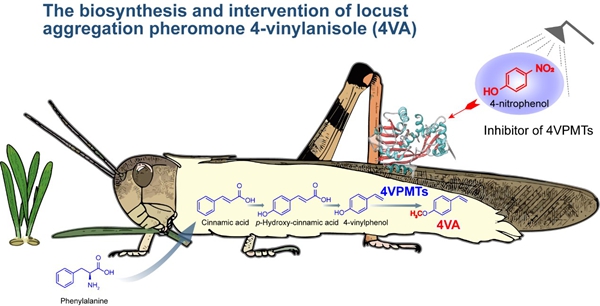
A team of Chinese researchers has uncovered the biological mechanisms behind locust swarming, offering new insights into how humans might intervene in the destructive behavior, according to a recent study published in Nature.
Led by Prof. KANG Le from the Institute of Zoology of the Chinese Academy of Sciences, in collaboration with Prof. LEI Xiaoguang from Peking University, this study focused on 4-vinylanisole (4VA)—a pheromone released by gregarious locusts that drives their mass aggregation and migration, which can devastate crops.
The team traced 4VA's origins to plant-derived phenylalanine (Phe), mapping its step-by-step conversion: phenylalanine (Phe) → cinnamic acid (CA) → p-hydroxycinnamic acid (p-HCA) → 4-vinylphenol (4VP) → 4VA.
The conversion of Phe, CA, p-HCA takes place in the gut of locusts, and p-HCA is released from the gut to spread through the hemolymph and is converted into 4VP, which is ultimately synthesized into 4VA and released outside the body. In addition, this study revealed that locusts can acquire Phe, CA, and p-HCA directly from plants, while performing only the final 4VP-to-4VA conversion.
Why do solitary locusts not produce 4VA while gregarious locusts do? While both solitary and gregarious locusts contain Phe, CA, p-HCA, and 4VP in their tissues, only gregarious locusts convert 4VP to 4VA. This difference hinges on a methylation reaction catalyzed by two methyltransferases, 4VPMT1 and 4VPMT2.
These enzymes act as "molecular switches": Their activity rises with locust population density. When silenced via RNA interference (RNAi), 4VA release plummeted and gregarious locusts shifted toward solitary behavior.
To further investigate this, the researchers conducted crystallographic and biochemical analyses. The findings revealed how 4VPMTs facilitate the production of 4VA. In 4VPMT2, the aromatic amino acid H137 forms π–π interactions with 4VP, which stabilizes the reaction. In contrast, in 4VPMT1, hydrophobic residues (V278, M203) and a hydrogen bond from Y61 stabilize 4VP, while W174 enhances enzyme activity through π–π interactions.
Seeking ways to block 4VA, the team tested 4VP analogs and identified 4-nitrophenol (4NP) as a potent inhibitor of both 4VPMTs. Even at low concentrations (0.1 nmol), 4NP reduced 4VA production in gregarious locusts. When applied to wheat sprouts, it curbed 4VA release and shifted gregarious locusts to solitary behavior, even reversing induced gregariousness in normally solitary individuals.
The study not only deciphers the molecular basis of locust aggregation but also lays the groundwork for pheromone-targeted pest management, offering a sustainable alternative to traditional pesticides.

The biosynthesis and intervention of locust aggregation pheromone 4-vinylanisole (4VA). (Image by Prof. KANG's Lab)

86-10-68597521 (day)
86-10-68597289 (night)

52 Sanlihe Rd., Xicheng District,
Beijing, China (100864)

